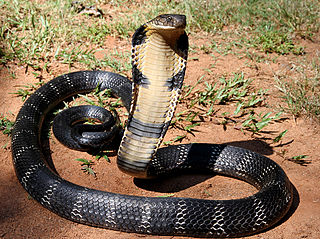
Snakes are elongated, limbless, carnivorous reptiles of the suborder Serpentes. Like all other squamates, snakes are ectothermic, amniote vertebrates covered in overlapping scales. Many species of snakes have skulls with several more joints than their lizard ancestors, enabling them to swallow prey much larger than their heads. To accommodate their narrow bodies, snakes' paired organs appear one in front of the other instead of side by side, and most have only one functional lung. Some species retain a pelvic girdle with a pair of vestigial claws on either side of the cloaca. Lizards have independently evolved elongate bodies without limbs or with greatly reduced limbs at least twenty-five times via convergent evolution, leading to many lineages of legless lizards. These resemble snakes, but several common groups of legless lizards have eyelids and external ears, which snakes lack, although this rule is not universal.

The king cobra is a venomous snake endemic to Asia. With an average length of 3.18 to 4 m and a maximum record of 5.85 m (19.2 ft), it is the world's longest venomous snake. Coloration of this species varies across habitats, from black with white stripes to unbroken brownish grey. The sole member of the genus Ophiophagus, it is not taxonomically a true cobra despite its common name. The king cobra inhabits forests from South to Southeastern Asia where it preys chiefly on other snakes, including those of its kind. A female king cobra builds a nest to hold its eggs which will be protected throughout the incubation period.

Colubridae is a family of snakes. With 249 genera, it is the largest snake family. The earliest species of the family date back to the Oligocene epoch. Colubrid snakes are found on every continent except Antarctica.

Squamata is the largest order of reptiles, comprising lizards, snakes, and amphisbaenians, which are collectively known as squamates or scaled reptiles. With over 10,900 species, it is also the second-largest order of extant (living) vertebrates, after the perciform fish. Members of the order are distinguished by their skins, which bear horny scales or shields, and must periodically engage in molting. They also possess movable quadrate bones, making possible movement of the upper jaw relative to the neurocranium. This is particularly visible in snakes, which are able to open their mouths very wide to accommodate comparatively large prey. Squamates are the most variably sized living reptiles, ranging from the 16 mm (0.63 in) dwarf gecko to the 6.5 m (21 ft) Reticulated python. The now-extinct mosasaurs reached lengths over 14 m (46 ft).

The Acrochordidae, commonly known as wart snakes, Java wart snakes, file snakes, elephant trunk snakes, or dogface snakes are a monogeneric family created for the genus Acrochordus. This is a group of basal aquatic snakes found in Australia and tropical Asia. Currently, three species are recognized.

Toxicofera is a proposed clade of scaled reptiles (squamates) that includes the Serpentes (snakes), Anguimorpha and Iguania. Toxicofera contains about 4,600 species, of extant Squamata. It encompasses all venomous reptile species, as well as numerous related non-venomous species. There is little morphological evidence to support this grouping, however it has been recovered by all molecular analyses as of 2012.

Lophostoma is a genus of Central and South American bats in the family Phyllostomidae.

Schultz's round-eared bat is a species of bat in the family Phyllostomidae. It is found in Brazil, French Guiana, Guyana, and Suriname.
Michael Wilmer Forbes Tweedie was a naturalist and archaeologist working in South East Asia, who was Director of the Raffles Museum in Singapore.

The Calamariinae are a subfamily of colubrid snakes, commonly known as reed snakes, that are found in southern and southeastern Asia. They are most diverse in Indonesia, especially Sumatra and Borneo. The subfamily contains 90 species in seven genera. Very few specimens of most species have been collected.
Argentinoeme is a genus of beetles in the family Cerambycidae, containing the following species:
Argentinoeme schulzi is a species of beetle in the family Cerambycidae. It was described by Bruch in 1911.
Macrocalamus is a genus of snakes of the family Colubridae.
Macrocalamus lateralis, the side-blotched reed snake, Malayan mountain reed snake, or striped reed snake, is a species of snake in the family Colubridae. The species is endemic to southern Thailand and Peninsular Malaysia.

Colilodion schulzi is a species of beetles belonging to the family Staphylinidae. This small, robust, reddish-brown rove beetle is known from a single specimen, a 2.37 millimetres (0.093 in) long female. It resembles the species C. concinnus and C. inopinatus with its enlarged antennomeres III, but it is easily distinguished by the greater maximum width and less variable width of these appendages, and by other morphological characteristics. Although its ecology is unknown, the presence of trichomes and the knowledge of related species, such as Staphylinidae suggests that this insect is myrmecophilous. The holotype was collected in 2009 in Palawan (Philippines) while sifting plant debris in a coniferous forest. The species was described in 2016 by the coleopterists Zi-Wei Yin from Shanghai Normal University and Giulio Cuccodoro from the Natural History Museum of Geneva, where the type specimen is part of the collection. The taxon's specific denomination is dedicated to the German myrmecologist Andreas Schulz, collector of the specimen.
Macrocalamus chanardi, Chanard’s reed snake, is a species of snake in the family Colubridae. The species is endemic to Malaysia.
Macrocalamus emas, the golden-bellied reed snake, is a species of snake in the family Colubridae. The species is endemic to Malaysia.
Macrocalamus gentingensis, the Genting Highlands reed snake, is a species of snake in the family Colubridae. The species is endemic to Malaysia.
Macrocalamus tweediei, Tweedie's reed snake or Tweedie's mountain reed snake, is a species of snake in the family Colubridae. The species is endemic to Malaysia.
Macrocalamus vogeli, Vogel's reed snake, is a species of snake in the family Colubridae. The species is endemic to Malaysia.










